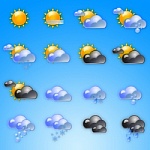 How do people know when a storm is coming? What signs in nature allows them to see these things?
How do people know when a storm is coming? What signs in nature allows them to see these things?
Centuries old manuscripts and inscriptions tells us how these weather patterns underwent careful observation and study by sages as early as 300 BC. Babylonians learn to foresee weather by looking at cloud patterns.
In Greece, books about weather forecasting have been written way back 340 BC by Greek philosophers Aristotle and Theophrastus entitled Meteorologica and Book of Signs respectively.
Indians and Chinese have also developed methods of weather forecasting at an earlier time of about 300 BC. Later in 904 AD, astrologists developed more sophisticated approaches to weather-prediction including changes in the atmosphere, extra-planetary signs, wind movements and phases of the moon. Ibn Wahshiyya gives a detailed explanation of these things in his book Nabatean Agriculture.
Recurrent changes in the earth’s atmosphere became the primary source of information for ancient astrologists. The way they record their observations are pretty straightforward. A deep red sunset, for instance, often signifies good weather conditions the following day. These observations were then kept and stored for succeeding generations. However, these weather lore, are found to have some flaws with their predictions. Statistical testing revealed that these observations have little or no correlation at all.
Modern weather forecasting didn’t start until the 19th century. Francis Beaufort and Robert Fitzroy are known as the pioneers of the science of forecasting. Initially, their works hasn’t gained recognition and in fact received much criticism from the press. But as their work gained credence through science, it has become the cornerstone of modern forecasting. One of the treatise discussed cloud formations and classifications.
The arrival of the age of computing in the 20th century brought forth great advances in weather forecasting. Programmable computers provide measured, precise calculations from numerical data in order to predict weather. Lewis Fry Richardson was the first to propose this method in 1922 but his works were not completed due to the vast amount of data and calculations that has to be made. It was in 1955 that his works gained practical use with the development of computers. In the later years, weather forecasting entered the mass media through radio broadcast in 1925 and television forecasts in the 1940s.

